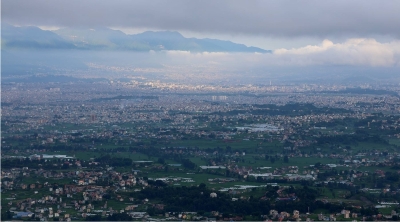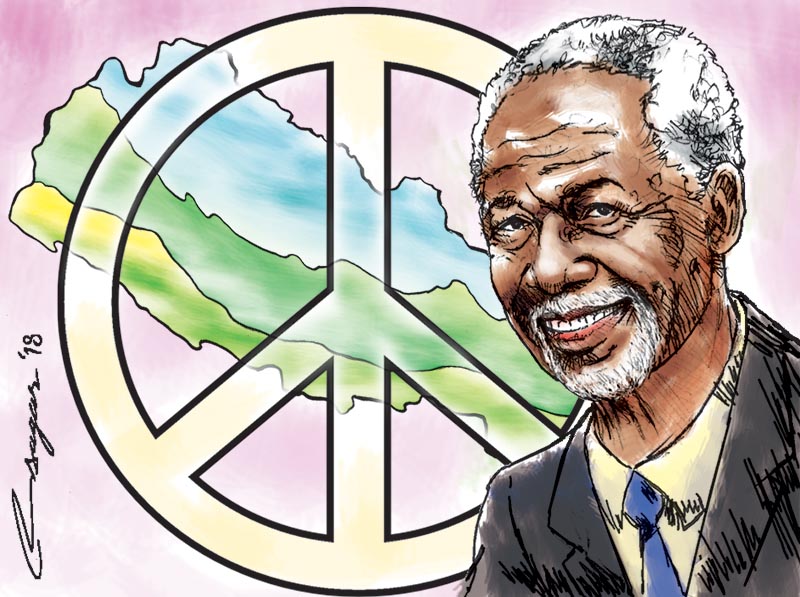Remembering Annan: His role in peace process
Had Annan not played a crucial role, Nepal’s peace process, which started in 2006, would not have been completed. Nepal will always remain obliged to him for laying the foundation stone of the peace process
Kofi Annan, who served two terms as Secretary-General of the United Nations, breathed his last August 18. The pioneer role played by him for peace building in Nepal is still fresh in the minds of the Nepali people. Had he not played his crucial role, the peace process, which started in 2006, could not have been completed, and Nepal could not have become a federal democratic republic in 2015.
The decade-long Maoist insurgency, which killed more than 13,000 people, displaced thousands and destroyed property worth millions of rupees, took a decisive turn in November 2005 with the signing of the 12-point understanding between then Maoists and the Seven-Party Alliance (SPA), proved to be the starting point of Nepal’s peace process. Point Three of the understanding stipulated to keep the Maoist armed force and then Royal Nepal Army under the United Nations or a reliable international supervision during the process of the election of the Constituent Assembly (CA) after the end of the autocratic monarchy, to accomplish the election in a free and fair manner and to accept the results of the election.
The choice between UN supervision and any reliable international supervision was finally settled in favour of UN supervision. Separate letters with similar contents were sent to Kofi Annan on August 9, 2006 by then prime minister GP Koirala and Prachanda, chairman, Central Committee, Communist Party of Nepal (Maoist), seeking involvement of the UN in monitoring human rights violations, its assistance in monitoring the code of conduct during ceasefire, managing of arms and armed personnel of both sides, deploying qualified civilian personnel to monitor and verifying the confinement of Maoist combatants and their weapons within designated cantonment areas, monitoring Nepal army to ensure that it remained in its barracks and its weapons were nor used for or against any side, and providing election observation to the election of the CA.
On the basis of the 12-point understanding, the SPA and the Maoists started the second people’s movement that threw autocratic monarchy and restored parliamentary democracy.
The Maoists and the government led by GP Koirala declared ceasefire and signed the Comprehensive Peace Accord (CPA) in November 2006. After signing of the CPA, on December 1, 2006 Annan initiated his prompt action by ordering advance deployment of 35 arms monitors and 25 electoral advisers to lay the concrete foundation of the peace process.
Only on January 23, 2007, the UN Security Council unanimously supported the establishment the United Nation Mission in Nepal (UNMIN) through its resolution 1740, with an initial 12-month mandate. Subsequently, Ian Martin was appointed Special Representative of the Secretary-General and head of UNMIN, who was then the Chief of the (United Nations) Office of the High Commissioner for Human Rights (OHCHR) in Nepal.
As per the Agreement on Monitoring of the Management of Arms and Armies (AMMAA) signed in the presence of Ian Martin, the Maoist combatants were to be placed in 28 cantonments sites—seven main sites, where weapons would be stored and 21 satellite sites. A joint Monitoring Coordination Committee (JMCC) was established to coordinate the implementation of AMMAA.
The UNMIN Monitors, who arrived in December 2006, completed the registration of the Maoist army personnel with the assistance of the Interim Task Force (ITF), which was established by the government and the Maoists. It consisted of 111 Nepali ex-Gorkha members of the Indian Army. UNMIN reported the registration results on March 8, 2007 to the JMCC. There were 31,252 personnel and 3,475 weapons registered with the UNMIN. From April 10 to 13, it registered and stored 2,855 weapons of the Nepal Army at Chhauni barracks in Kathmandu with 24-hour monitoring. Significantly, the second phase of registration, which started on June 19, took almost six months with the verification of age and the date of their recruitment to establish their eligibility as combatants.
The total number of registered Maoist army personnel was 32,250. However, only 19,602 were verified as meeting the criteria agreed, which comprised 15,756 men and 3,846 women; 8,640 did not appear for verification and 4,008 were under-age and were discharged from the cantonments.
Interestingly, some of the verified personnel joined the Nepal Army and most of them preferred voluntary retirement.
Annan took interest in the peace process and expressed his serious concerns over the ban on demonstrations by civil society. To him, security considerations could not be the basis for denying citizens’ right to peaceful protests. He had visited Nepal in 2001 and discussed about ongoing insurgency with king Birendra and advised ex-king Gyanendra on many occasions.
It seems that with his appointment as peacekeeping chief in 1993, a post he held till he assumed his responsibility as the Secretary-General was the prime motivator for being more concerned about the peace building in Nepal. Nepal will always remain obliged to for him laying the foundation stone of the peace process.
Mishra is ex-coordinator, National Monitoring Committee for Ceasefire Code of Conduct






